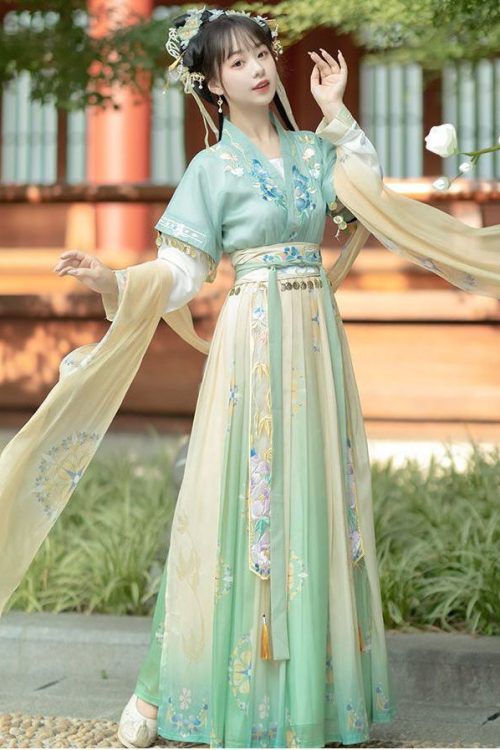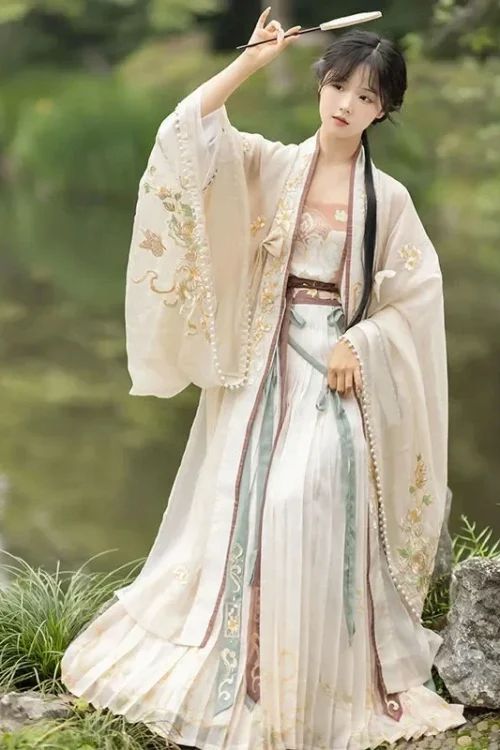The Evolution of 汉服: From Ancient Roots to Modern Revival
Traditional Patterns in Contemporary Fashion
The integration of traditional mountain and floral patterns into contemporary fashion marks a captivating fusion of ancient heritage and modern aesthetics. Hanfu, the traditional attire of the Han Chinese, has long been adorned with these intricate motifs, symbolizing the harmony between humanity and nature.

In recent years, designers have embraced these patterns, reinterpreting them in innovative ways. Mountain peaks, once depicted in flowing brushstrokes, now adorn sleek silhouettes, evoking a sense of grandeur and strength. Floral motifs, once delicate and ethereal, bloom in vibrant hues on contemporary garments, adding a touch of femininity and grace.
A Testament to Cultural Heritage
The integration of these patterns is not merely a nod to tradition but a testament to the enduring power of cultural heritage. Designers draw inspiration from ancient textiles, reinterpreting them with modern techniques and materials. The result is a seamless blend of past and present, creating garments that are both timeless and contemporary.

Moreover, the use of mountain and floral patterns reflects a growing appreciation for sustainability and environmental consciousness. Mountains represent the majesty of nature, while flowers symbolize its fragility. By incorporating these motifs into their designs, fashion designers are raising awareness about the importance of preserving our planet.
Versatility in Fashion
The integration of Hanfu patterns into contemporary fashion is not limited to traditional garments. Designers are experimenting with these motifs in a wide range of styles, from streetwear to haute couture. Mountain peaks and floral prints appear on everything from casual t-shirts to elegant evening gowns, creating a versatile and inclusive fashion aesthetic.
As the revival of Hanfu continues to gain momentum, the integration of its traditional patterns into contemporary fashion is a testament to the enduring power of cultural heritage. Designers are not simply replicating the past but reimagining it, creating garments that are both stylish and meaningful. By embracing these patterns, fashion becomes a bridge between tradition and modernity, connecting us to our cultural roots while embracing the future.
Floral Patterns in Haute Couture: A Timeless Motif Reimagined
The Influence of Traditional Motifs
The world of fashion has long been inspired by the rich tapestry of traditional cultures, and the integration of mountain and floral patterns from ancient Chinese Hanfu into contemporary haute couture is a testament to this enduring influence. These motifs, steeped in symbolism and cultural significance, have found a new lease on life in the hands of modern designers, who have reimagined them with a fresh and innovative perspective.

In traditional Hanfu, mountain patterns represented the strength and resilience of the Chinese people, while floral motifs symbolized beauty, prosperity, and the cyclical nature of life. These patterns were often intricately embroidered or woven into the garments, creating a visually stunning and meaningful ensemble.
Modern Interpretations
Contemporary designers have embraced these traditional motifs, incorporating them into their collections with a modern twist. For example, the renowned Chinese designer Guo Pei has showcased mountain patterns in her haute couture gowns, using bold colors and abstract shapes to create a striking and contemporary interpretation. Similarly, the Italian fashion house Dolce & Gabbana has featured floral motifs inspired by Chinese embroidery in their collections, combining them with Western silhouettes to create a unique and eye-catching fusion.
The integration of mountain and floral patterns in haute couture not only pays homage to Chinese cultural heritage but also reflects a broader trend towards sustainability and cultural appreciation in the fashion industry. By incorporating traditional motifs into their designs, contemporary designers are helping to preserve and promote cultural diversity while also creating garments that are both beautiful and meaningful.
A Renewed Interest in Cultural Heritage
Moreover, the use of these patterns in haute couture has sparked a renewed interest in traditional Chinese culture and its influence on global fashion. It has also inspired a new generation of designers to explore the rich symbolism and aesthetics of their own cultural heritage, leading to a more diverse and inclusive fashion landscape.
In conclusion, the integration of traditional mountain and floral patterns from Hanfu into contemporary haute couture is a testament to the enduring power of cultural heritage in shaping the world of fashion. By reimagining these motifs with a modern perspective, designers are not only creating visually stunning garments but also fostering cultural appreciation and promoting sustainability in the fashion industry. As the world continues to embrace diversity and cultural exchange, we can expect to see even more innovative and inspiring integrations of traditional motifs in contemporary fashion.
The Fusion of Tradition and Innovation: Mountain Patterns in Contemporary Fashion
Bridging Heritage and Modern Aesthetics
The integration of traditional mountain and floral patterns into contemporary fashion has emerged as a captivating trend, bridging the gap between ancient heritage and modern aesthetics. This fusion has its roots in the rich cultural tapestry of China, where the Hanfu, a traditional garment, has long showcased intricate mountain and floral motifs.
In recent years, designers have drawn inspiration from these timeless patterns, reinterpreting them in innovative ways. The result is a harmonious blend of tradition and modernity, where ancient symbols find new life in contemporary silhouettes.

The Significance of Mountain Patterns
Mountain patterns, with their rugged peaks and flowing lines, evoke a sense of grandeur and strength. Designers have incorporated these motifs into everything from flowing gowns to tailored suits, creating garments that exude both elegance and a touch of the untamed. Floral patterns, on the other hand, bring a touch of femininity and grace to contemporary fashion. Delicate petals and blooming buds adorn dresses, skirts, and blouses, adding a touch of whimsy and romance.
The integration of these traditional patterns into contemporary fashion is not merely an aesthetic exercise. It is a testament to the enduring power of cultural heritage and the ability of fashion to transcend time and boundaries. By embracing these motifs, designers pay homage to the past while simultaneously pushing the boundaries of fashion forward.
A Message of Hope and Empowerment
Moreover, the use of mountain and floral patterns in contemporary fashion has a deeper significance. Mountains represent resilience and determination, while flowers symbolize beauty and growth. By incorporating these motifs into their designs, designers create garments that not only look stunning but also carry a message of hope and empowerment.
The fusion of tradition and innovation in contemporary fashion is a testament to the ever-evolving nature of style. As designers continue to draw inspiration from the past, they create garments that are both timeless and relevant, bridging the gap between heritage and modernity. The integration of mountain and floral patterns into contemporary fashion is a prime example of this creative synergy, showcasing the enduring power of tradition and the boundless possibilities of innovation.
